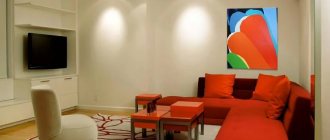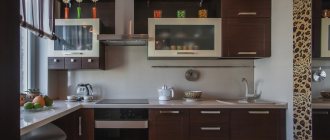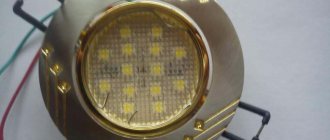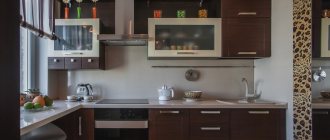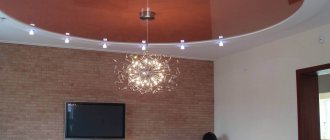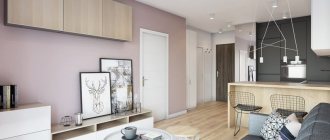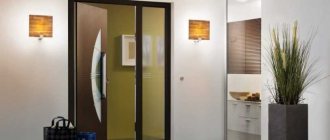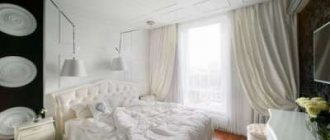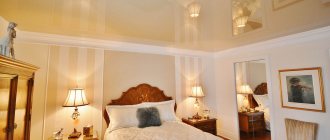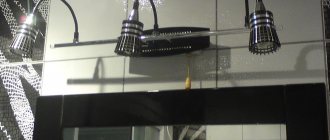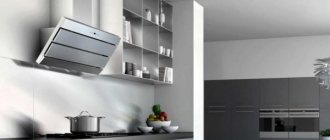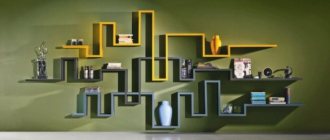Lighting plays an important role in the decor of a room. A correctly selected arrangement of lamps on a suspended ceiling or other decoration can transform a room beyond recognition; in a large hall, the space can be zoned, and a small area can be visually expanded. As an example, we will give several typical lamp placement schemes, and also present interesting design solutions for various types of premises. Since spot lighting (spots) is now popular in interior design, maximum attention is paid to it.
Device features and benefits of use
Spotlights got their name due to the small size of the lamp and the external effect of radiation from a single point. The lamp is enclosed in a shade; hence the main feature of the spots: the light dispersion angle does not exceed 30°, and the light flux itself has the shape of a cone.
A small angle allows you to illuminate a limited part of the space, so for uniform lighting, use a group of spots with a fairly dense arrangement.
The steady demand for spot lighting is explained by the following benefits of use:
- Spots are practically invisible and therefore adapt to any interior. Small ceiling lamps are hidden under the surface when installed and therefore do not burden the space.
- You can choose spots for any style. Some models allow you to adjust the direction of the light, which increases their design capabilities.
- You can evenly illuminate any room. A chandelier does not always cope with this task, but well-placed spots on the ceiling will easily solve the problem.
- You can organize partial lighting of the room, and thereby significantly save electricity.
Types of spotlights
If we talk about appearance, then, in addition to round ones, there are models of square, oval and non-standard shapes. It is convenient to classify spotlights according to the place of attachment:
- Built-in. Such lighting fixtures decorate suspended and suspended ceilings, walls and stairs. They require lamps with a minimum heating level so as not to damage the base.
- Invoices (external). There are wall and ceiling; the structure is fixed with screws, the light flow is distributed by the diffuser of the outer housing.
- Furniture. Mortise and overlay spot models help illuminate furniture fronts, work surfaces, as well as the interior space of shelves and drawers.
- Hanging. Such spotlights take up more space in the interior, since installation is carried out on special mounts, and the device remains visible. Many hanging models are equipped with a rotating mechanism.
Built-in ceiling models, in turn, differ in the type of installation:
- Models for installation in rigid suspended structures (plasterboard, plastic panels, slatted ceilings); equipped with two fastening clips.
- Models for suspended ceilings. In this case, installation is carried out using special brackets before the canvas is tensioned.
LED lighting options for ceilings
Ceiling lighting allows you to diversify the design, highlight the necessary areas and fill the room with an extraordinary atmosphere. Hidden lighting can serve as both primary and additional lighting.
LEDs on the ceiling in the living room interior Source design-homes.ru
Advantages of LED backlight:
- With its help, you can create hidden lighting, which is invisible when turned off, and in the evening creates a cozy and romantic atmosphere in the room.
- Easy to install, installation does not require special knowledge.
- Allows you to turn bold and unusual design fantasies into reality.
- Can act as the main light source.
- LEDs consume little electricity, which saves money.
- Used to divide a room into functional zones.
- Performs a decorative function, the choice of shades is huge. You can always choose the color of the LEDs to match the color scheme of the interior.
Living room with lighting on the ceiling Source potolokelite.ru
In addition to the advantages, LEDs also have disadvantages:
- high cost, but fairly cheap service;
- bright lights can be irritating.
There are several types of ceiling lighting that can be used for a variety of interiors:
- Contour scattered. In this case, the LEDs are located around the perimeter. The color and location of the LED strip allows you to create an unusual atmosphere in your living space; the appearance of the room changes completely. The light source is hidden under the suspended ceiling, making the light transition smooth and soft. The tape is attached to a special recess, from where the light is directed onto the ceiling surface and distributed evenly, forming a solid line.
- Directed. The LED strip is attached to a slope located between two levels. The light is directed along the ceiling.
- Spot. Light sources are installed separately, creating an imitation of the starry sky. For them, special holes are made in the canvas; this is a rather complex and lengthy process. Light rays are directed from the ceiling surface to the floor or walls.
- Curly. Small lampshades for LEDs are mounted in the ceiling; as a result, the light is directed in different directions, creating interesting and unusual shapes, patterns and designs.
Ceiling with spot lighting Source vippotolok.ru
LEDs operate on low voltage, so they are less fire hazardous, the likelihood of electric shock to a person is low, but you should always be careful.
The original finishing method is a floating stretch ceiling. In this case, the LED strip is placed around the perimeter, visually increasing the height of the ceilings, creating the impression that the canvas is floating in the air.
Soaring ceiling in the living room Source design-homes.ru
How many spots are needed and how to place them
To determine the optimal number of spotlights (if you mean main lighting), there is a special formula, but the calculation can be done in a simpler way. To do this, the following calculations are carried out:
- The total number of watts per room is determined. The area of the room is multiplied by the number of Watts required by lighting standards per 1 m2. According to SNIP, the lighting level for a bedroom is 12 W/m2, for a nursery - 15 W/m2, for a living room - 20 W/m2.
- To determine the minimum number of lamps, the total number of Watts is divided by the power of the selected lamp.
Inverse problem: to determine the power of one lamp, the total number of Watts is divided by the number of lamps.
Spotlights are installed taking into account the following conditions:
- The distance to the wall must be at least 70 cm.
- To determine the distance between lamps, the length of the wall is divided by the number of spots.
- To determine the distance of the lamps from the wall, half the length of the wall is divided by 2.
Popular layouts for placing lamps on a suspended ceiling in combination with a chandelier
The location of additional lighting devices is primarily determined by the position of the central one - the chandelier. There are options here too: in a classic small living room, the chandelier is fixed exactly in the center, and spotlights are placed symmetrically around it. In modern styles, a chandelier marks the most important area of the living room, and lighting is grouped by zone. In this case, asymmetry is allowed.
The options for placing spotlights on a suspended ceiling are as follows:
- An oval is a great way to visually correct the proportions of a long and somewhat narrow living room . A chandelier is installed in the center, and spots are placed around in the form of an oval. Part of the ceiling may be darkened;
- circle - ideal for a square living room;
- 2 semicircles - with modern design, arcs can have different lengths and bending radii . A simple and at the same time extremely effective way to visually correct the proportions of a room;
The photo shows a circular arrangement of spotlights on a suspended ceiling in the hall.
- framing - this means installing lighting on a plasterboard ceiling box around the perimeter. The scheme emphasizes the proportions of the room;
- A classic option for a kitchen or small bedroom is to install spotlights parallel to two shorter walls. In this way, they achieve visual expansion of a narrow room;
- corner – point models are fixed along the corner symmetrically or asymmetrically. This method is only permissible in modern styles, and is very popular when zoning;
- grouping - applicable in a studio apartment . At the same time, in the guest area, for example, a chandelier is hung, and in the area where the owner of the home is resting, a group of lamps is placed;
- an arbitrary combination is also usually asymmetrical . In this case, a row of lamps is placed in the form of a wave, zigzag, semicircle, and so on.
The photo shows how to place spotlights on a suspended ceiling in the hall.
When choosing a pattern, the nature of the canvas is also taken into account. The glossy film reflects light, so you'll need fewer fixtures to illuminate your living room or bedroom. Matte or velvet fabric even absorbs light: more lamps are needed here.
Advantages and disadvantages
Positive and negative qualities of products that will help you understand whether this lighting method is beneficial.
Advantages
- Due to their compactness, they fit perfectly into the design of any room in an apartment or house.
- Can be used both as main and additional lighting.
- They allow you to achieve zoning of space and provide light to individual areas.
- By using spotlights with LEDs or halogen bulbs, energy costs are reduced.
- This type of lighting is characterized by an unlimited choice of installation locations. The products can decorate any area, niche, arch, etc.
Due to models with spectacular decor, it is possible to advantageously emphasize the style of the interior.
Lamps with warm or cool shades can create a comfortable atmosphere in the room and give the design a certain mood, depending on individual preferences.
Flaws
- Surface-mounted and recessed lighting fixtures have some installation difficulties and require a professionally designed installation diagram.
- For products with 12 Volt light bulbs, the purchase of a special step-down transformer is required.
- Some types of light sources require a ceiling with a special design.
Design ideas
A popular design option is the starry sky. The composition is created using miniature light bulbs that imitate twinkling stars or entire constellations in the clear night sky. This method of lighting allows you to create a romantic atmosphere in the room.
Original double models, the light from which can fall on two different objects at once, will organically fit into a modern interior. Certain objects need exactly this distribution of light flux so that it attracts more attention.
Lighting fixtures also come in a variety of shapes. There are products stylized as a square, triangle, circle or hexagon. The design features of the mounting hole depend on the configuration of the light source.
The photo shows a kitchen with a suspended ceiling decorated with double point models.
Models with white matte or black coating are able to organize an interesting light supply. White lighting fixtures on a white ceiling will contribute to the visual expansion of the space and add laconicism to the atmosphere. Black lamps represent a bolder solution that ideally complements an unusual Gothic or strict modern interior.
For a room designed in a classic style, you can also choose suitable products. The lighting market includes devices decorated with a wreath with voluminous crystal petals, models with faceted glass shades, designs with a silver, gilded body or a carved bleached base.
Lamps with a metal frame, decorated with decorative inserts made of colored glass, look very stylish. This way you can achieve an interesting glow, give the interior a special zest and add magic to the atmosphere.
The photo shows spotlights in the ceiling design with an imitation of the starry sky in the living room interior.
Ceiling options
The placement of spotlights needs to be thought out in advance, especially if a suspended ceiling is to be installed.
The backlight can be located either symmetrically or in a chaotic manner.
Light sources built into a multi-level suspended or suspended ceiling will allow you to create a unique interior, highlight the architecture and atmosphere of the room.
The lighting will be uniform and of the highest quality if the devices are installed so that the rays of the light flux intersect above all elements in the room.
The best option is built-in spotlights along the perimeter of the ceiling plane. They can be switched on together with a central chandelier to create more intense lighting.
The parallel arrangement of lamps in several rows will help to achieve proper comfort in the room.
A cross-shaped arrangement of light sources will fit perfectly into a small room with a low ceiling. The corner space is equipped with single models, and a gimbal structure is installed in the center.
Also, for a small room, the arrangement of lamps in the form of a square is appropriate.
In order to illuminate a certain area, an arc-shaped arrangement of lighting fixtures is used. Thanks to this technique, it is possible to soften the strict interior.
Some rooms require the installation of light sources in a checkerboard pattern. For example, a similar solution is often found in the design of an island-type kitchen, where good lighting of all zones is required.
In what interior style is ceiling lighting used?
The choice of design options for a stretch ceiling with lighting is huge, but such an unusual decor is not suitable for every stylistic direction. For example, in a classic or ethnic interior, LED lighting will be inappropriate.
A stretch ceiling with lighting will go well with modern styles, such as:
- high tech;
- minimalism;
- loft;
- futurism.
Modern stylistic trends support the idea of preserving free space; they lack unnecessary furniture and decorative elements. The interior, decorated in restrained colors without bright accents, can be complemented by original lighting on the ceiling. The lighting will favorably emphasize the simplicity of the interior and fill the room with a mysterious atmosphere. Fixtures can illuminate walls, creating a beautiful light pattern or design.
Stretch ceiling in a high-tech interior Source masterpotolok.com
In such interiors, lighting will emphasize the modernity and high-tech nature of the room. If there is a need and an irresistible desire to complement a classic interior with a stretch ceiling with lighting, you should give preference to more restrained shades and simple options for placing LEDs.
The lighting can be adapted to any style direction. It is important to take into account the characteristic features of a particular design. A white stretch ceiling with lighting around the perimeter will suit almost any interior; in this case, an LED strip is used to increase illumination.
Stretch ceiling with lighting in a Scandinavian style kitchen Source yellowhome.ru
In the interior of a predominantly white Scandinavian kitchen, a suspended ceiling with lighting looks harmonious; it does not stand out against the general background, and LEDs are a source of additional light. During daylight hours, the lighting on the ceiling is invisible, and with the onset of darkness the room takes on a more modern and stylish look.
Ceiling lighting in a black and white living room Source realty.mail.ru
The black and white interior in the minimalist style was complemented by a multi-level design with lighting. Spotlights directed at the walls create an unusual pattern, and LEDs emphasize the modernity of the stylistic direction.
Photos in the interior of the rooms
Features of installing lamps in the interior of specific premises.
Spotlights in the kitchen
The kitchen space requires a lot of light. It is advisable to install several devices with a bright and soft light flux. In this way, you will learn how to create enough lighting in the kitchen and at the same time achieve a pleasant environment.
If there is not enough free space, you can equip the kitchen wall cabinets with lighting.
Spot lighting in the kitchen in combination with an LED strip of different colors will add even more originality to the design.
Spotlights in the living room interior
In the interior of a living room with a ceiling chandelier, it is better to install light sources with low power. Thus, when the chandelier is turned off, a pleasant, soft and muted glow will emanate from the lamps
. In this case, point devices can be placed only on one side of the ceiling.
For a hall without a central chandelier, almost any arrangement of light sources is suitable, for example, in the form of a circle, square, oval or even a diamond.
Examples in the interior of the corridor
Typically, the design of a hallway assumes the most simple arrangement of lighting fixtures. For a narrow corridor, one row of 3 or 5 point lamps is suitable. In a square room, it is appropriate to install two rows consisting of 3 or 4 light bulbs.
Spot lighting in the bedroom
Perimeter lighting will look great here. A good solution is to install a multi-level stretch ceiling, decorated with dim lighting.
LED strip mounted on the sides of the ceiling plane will complement spotlights advantageously.
Thanks to light sources, the bedroom can additionally be divided into an area with a bed, dressing table or wardrobe.
Photo examples
It is worth giving a few examples to complete the picture. Below are descriptions with photo examples showing possible solutions for the home. Among them there will be both standard schemes and original compositions.
For kitchens
The kitchen is the brightest room in the apartment. It is impossible to cook food in the twilight, so you need to provide a powerful luminous flux. It is better to zone the room: a separate place for cooking and dining. The “I” and “K” systems are common.
The second option is suitable for large areas. One line of instruments runs through the center, and additional lines of light diverge from it. This way you can flood the entire room with light.
It is important that the work area is well lit. Lamps in the kitchen can be positioned in an L shape, focusing on the cutting table. In large rooms, a chandelier is often installed above the dining area to distribute light evenly.
For the hall
The main room in the apartment should have cozy lighting, which will be pleasant to be in. The classic option is the main lighting in the form of a chandelier and auxiliary lighting. The design of suspended ceilings with spotlights and chandeliers is common due to its simplicity and efficiency. In such a room it will be pleasant to watch TV, read, communicate with family and friends.
Lamps in the living room can be placed randomly or according to your design. The uneven distribution of light allows for zoning, creating separate areas for rest and work. The scheme is common in studio apartments, where there is a lot of space.
For the bedroom
The bedroom is a place to relax. Therefore, lighting should be moderate and soft. Using classic systems of LED spotlights for suspended ceilings of type E (8 points) or H (11 points), harmonious lighting is obtained. It is advisable to supplement it with a dimmer to adjust the light. Smooth controls will allow you to adjust the mode for reading, sleeping, relaxing or watching TV.
The organization of lighting requires harmony with the interior design. The bedroom is the most furnished room, so the light will take on the palette of the overall atmosphere.
For children's room
The children's room is a multifunctional room, which is characterized by a clear zoning into a play area, a place for study and sleep. It is advisable to install powerful spots above the table that can provide the required amount of light. To avoid damaging your eyesight, you can install an additional table lamp.
A place to sleep does not need strong lighting, so a sconce will do. This element will create a warm relaxing atmosphere. It can be used as a night light or for reading before bed.
It is not advisable to install a hanging chandelier, as a child may break it while playing. The spot system will completely eliminate any need for a chandelier.
For the hallway
There is no need to install performance lighting in the corridor, so there is no need for a central chandelier. Houses and apartments with low ceilings will not allow you to turn around, which will make you feel cramped.
A convenient way to organize it would be to install spotlights along the perimeter walls. In a narrow corridor, it is better to install one line of lighting fixtures along the entire length. The small space will be well lit, and you will not feel discomfort. On multi-level ceilings it is possible to create a beautiful composition of dots.
For bathroom
In panel houses, the bathroom is small, so there are not many algorithms for lighting equipment. The classical organization of light is considered to be the “B” system. It is possible to install sconces near the mirror.
In spacious rooms you can give free rein to your imagination. For example, several lines of spots are often installed. Zoning emphasizes the breadth of the room, visually increasing its area.
Light sources in spotlights
Various types of lamps can be installed in these lighting devices. Manufacturers' products include incandescent, halogen and fluorescent light sources. All of these devices have certain pros and cons. But the best option is LED ceiling spotlights.
They have several obvious advantages that set them apart from other light sources.
LEDs:
- have maximum light output;
- use electrical energy economically;
- create uniform light;
- have the longest service life.
These devices have another important advantage. The LED recessed ceiling lamp can be installed in tension systems without fear for the integrity of the canvas.
During operation, these light sources practically do not emit heat and do not have a negative impact on the structure of the polyvinyl chloride coating.
Mounting type
The light source can be mounted on:
- Overlay rings. They install simple low-power light bulbs. This is due to the small distance between the suspended ceiling and the ceiling tiles. Lamps may have a rotating mechanism;
- Spring fastening. This is how they achieve a tight fit between the canvas and the lamp. The result is powerful lamps that practically do not stand out from the general background. A decorative overlay attached to the outside holds the film (or fabric);
- Hook built into the slab. This method is considered the simplest. It is used when installing models that are relatively light in weight.
Ceiling mounting (fourth method) is rarely used in residential premises. Experts explain this by the complexity of the work and the inconvenience of use. The idea is simple: the lamp is mounted on a platform, the installation of which was carried out even before the canvas was stretched. The disadvantages include a high risk of a ceiling breakthrough and possible overheating of the material.
Determining optimal power
Determining the required power depends on several factors:
- purpose of the system;
- room area;
- ceiling height;
- lamp parameters.
The use of recessed or overhead spotlights for ceilings as the main lighting requires calculations according to general rules. On average, a 35W light source is installed per 2m2 of area. If this is additional lighting, the indicators of the ceiling chandelier are subtracted from the total power.
When creating comfort in a certain area, the fundamental calculation criterion is its area.
The number of light sources required depends on the type and power of the lamps. Halogen, traditional, LED recessed spotlights have different parameters.
Many models are designed to accommodate any type of lamp.
Main characteristics
Before purchasing LED light bulbs, you should decide how the light will fall in the room and what placement they plan to have relative to the ceiling.
If at the same level, the luminous flux will be narrowed, since the devices are partially closed. Such lighting is suitable, for example, when zoning a room. But it should be taken into account that with such a hidden installation there is a risk of damaging the tension surface during repairs.
If the lighting fixtures are placed below the tension structure, the lighting will be more diffused and evenly distributed along the entire perimeter of the room.
Spotlights are divided into two types:
- rotary;
- not rotary.
What functions each type has is indicated by their name. The first one has great potential. The built-in rotary ring makes it possible to direct the flow of light in the desired direction. This way you can illuminate the far corners of the room, which often remain shaded under normal lighting.
If this function is not needed, then choose the second type, when the light is directed straight down. This is used for a bedroom, or if you need to divide the room into zones.
The designs of non-rotating spotlights are more durable and installing them in a suspended ceiling is easier.
Lighting fixtures are determined by the type of light source:
- halogen lamps;
- with filament;
- LED
The last type is the most popular because it gives a high level of brightness with little heating, lasts a long time and makes it possible to change the shade of the backlight.
In addition to luminous flux and power, no less important points when purchasing are the type of base, supply voltage and degree of protection of the device.
Halogen lamps, as well as LED ceiling lamps, in some versions may require a power supply when connected. Then you need to think about where to install this block. It would be better if you mount it near the eaves, in a niche. Then, in case of replacing the battery, it will be possible to do without complete dismantling.
Lamp arrangement
All spotlights have a similar design, including:
- mounting base;
- housing with diffuser;
- Light source;
- connecting cable.
The model range of these lighting products includes various modifications with more complex designs and additional devices. Built-in and overhead ceiling spotlights can be adjusted by remote devices. There are models with an extended lighting angle, equipped with dimming that corrects the illumination.
Lamps differ in the level of protection from dust and moisture, which determines the scope of their intended use.
Installation of spotlights
The question of how to install a spotlight is of interest to many craftsmen who are doing this for the first time. There is nothing complicated in this work.
The main thing is to decide on the installation method and carry out all the work as carefully and accurately as possible.
It is worth noting that, depending on the installation method, a distinction is made between recessed and surface-mounted lamps.
Let's take a closer look at both types:
- Built-in. When installing such spotlights, a hole is made in the canvas. The lamp is installed in such a way that part of its body protrudes outward, that is, it turns out to be built into the ceiling surface.
Such lamps are used on frameless bases, such as a brick wall or a concrete ceiling.
- Surface- mounted spotlights are used exclusively for suspended ceilings. Their level is always below the ceiling level.
When choosing spotlights, you must take into account the method of mounting them - this will allow you to avoid annoying mistakes. Installation of overhead lamps requires the presence of a frame.
In turn, recessed lamps can be divided into two groups depending on their purpose. They can be for suspended or suspended ceilings.
The configuration of spotlights directly depends on their type. Thus, the standard design of a surface-mounted luminaire consists of a special housing equipped with a diffuser and a fastening part.
A recessed lamp consists of fasteners and clamps for lamps built into a special housing.
Installation of such lamps is extremely simple; even a beginner can cope with this task.
Popular luminaire layouts
There are many options for lighting design, but it is not possible to name the most optimal location of ceiling lights. This is due to the fact that it is necessary to take into account many factors, from the area of the room to the location of the windows. You should also decide whether spotlights will be used as additional lighting (together with hanging chandeliers) or main lighting.
If possible, it is better to consult with a lighting designer about the placement of lamps. For those who decide to deal with this issue on their own, we can offer several standard options for placing ceiling lamps.
Figure 1. The most common schemes for additional lighting to the central chandelier
Such design options not only contribute to the uniform distribution of lighting over the entire area, but also, if necessary, allow for bright illumination of work areas.
Spots can also act as the main lighting fixtures; in this case, it is important to distribute them in such a way that they not only look beautiful, but also fulfill their intended purpose, fitting into the interior design.
Adjustment type
All of the above types of spotlights can also differ in the type of adjustment. Depending on this, spotlights are:
- non-rotating – illuminate part of the room, but the direction of the light flow cannot be adjusted;
- rotating - allow you to adjust the angle of incidence of light and its direction;
- rotating and retractable spotlights are used to change lighting zones.
In terms of functional features, spotlights can also vary significantly.
Modern models are equipped with remote control, have a wider angle of light incidence, protection against dust and moisture, and other functions.
Lamps for spotlights
The characteristics of spot lighting indicate that absolutely any lamps are suitable for them - incandescent, halogen, LED.
The choice of lamp type does not in any way depend on what type of lamps is selected.
Let's look at which lamps are better:
- LED lamps have a long service life - up to 5 years. They are economical in terms of electrical consumption, and their light is pleasing to the eye.
- Halogen lamps do not heat up, which is very important for suspended ceilings (especially film ones). The light from them is quite bright, but does not irritate the eyes. The service life of such lamps is decent - up to 4 thousand hours.
- Incandescent lamps have a lower cost compared to halogen and LED lamps. And this, perhaps, is perhaps their only advantage. Incandescent lamps get very hot, so they are rarely used for lamps such as spotlights.
Looking at photos of spotlights in various interiors, we can conclude that with proper and thoughtful placement, this type of lighting is an ideal option for almost any room.
Thanks to them, not only good, proper lighting is obtained, but also a stylish interior design.
In addition, spotlights are universal, because they will fit perfectly into any style, and the soft light will make the room warm and cozy.
How to install spotlights on a suspended ceiling
Installation of spots on a tension fabric involves attaching the lamp itself to the base ceiling. Lamp manufacturers have made installation as easy as possible. The product is supplied with an installation platform and the necessary fasteners. In addition, when attaching to PVC film, you will also need a thermal ring.
The procedure is as follows.
- Mounting points are marked on the base ceiling. Holes for the dowel are first made in the concrete surface; the installation platform is simply secured into the wood with self-tapping screws.
- Lay a cable to each output and secure it to the ceiling with brackets or clamps.
- After completing other preparatory work, stretch the PVC film.
- To prevent heating of the canvas, thermal rings are used. They are selected in advance according to the diameter of the lamp. After the suspended ceiling has been installed, the lamp mounting areas are marked.
- Special glue is applied to the thermal ring and secured to the canvas. The glue sets within 3–5 minutes. Then the fabric inside the ring is cut and its excess is removed.
- The lamp is inserted into the resulting hole, making sure that the spring antennae are behind the installation ring. If there is a small gap left between the canvas and the edge of the body, there is no need to remove it.
If spots are installed on a tire, the installation is done slightly differently. The holes are made for suspensions, that is, there is no need for thermal rings.
How to calculate the number of lamps
Before choosing a suitable arrangement of lamps, you need to calculate the required number. It should be calculated based on the standards. These standards vary significantly for different premises.
In non-residential premises, the light should not be as bright as in residential rooms. Current standards can be found in the relevant SNiPs.
The number of ceiling lighting fixtures is calculated as follows:
- You need to multiply the area of the room by the light standard according to the standard from the table above. The result will be the total lighting power (example: 16 m? * 150 = 2400 Lux).
- Next, determine the power of the lighting sources and their types. You should know their luminous flux (let's say this value is 200).
- Then the total power must be divided by the power of one lamp. This way you can calculate the number of lamps (2400:200Lx=12 pcs).
It happens that the standards specified in SNiPs imply too bright light. But sometimes you really want softer lighting. This must be taken into account when choosing methods for lighting the ceiling with spotlights.
It's better to do everything so that you can have different options. For this purpose, lighting devices are divided into groups.
If there are two groups, then they are connected through one to the line, and then connected to a switch with two keys. The first row of lamps on the ceiling can be the main one, the second - secondary. Then you can turn on the light bulbs one at a time, and as a result the glow will be either dim or very bright.
If necessary, the lamps can be divided into a larger number of groups, output them separately to different switches and turn on as needed.
General recommendations for room lighting
Various types of devices are used for lighting. More traditional - chandeliers. According to the method of fastening, they are divided into suspended and overhead. The first are mounted on a hook, and the second - on a bar.
In recent years, indoor lighting in houses and apartments usually consists of two components - a chandelier, as the main source of light, and small spotlights that create a certain atmosphere or additionally illuminate certain areas in the room. In some cases, wall lamps and/or table lamps and floor lamps are also added. But the basis is usually ceiling lighting.
In addition to different shapes and sizes, you can also choose a different glow color
Traditionally, the location of the chandelier is strictly in the center of the ceiling. This rule is very rarely deviated from - then it is too difficult to create a harmonious design. The exception is a combined space in a studio apartment or kitchen-living room. In this case, a chandelier (usually one) is placed in the center of one of the zones, the rest are illuminated by spotlights or other light sources. The location of the lamps on the ceiling must be selected taking into account the design and geometry of the room. And it's not that simple.
Rules for placing spotlights
The placement of spotlights on the ceiling is a matter of imagination and taste, but you should not neglect the technical nuances. Firstly, they must be placed taking into account the required illumination of various parts of the room: more light is usually needed above the table, maybe above the seating area, etc. Although, if necessary, you can “gain” the missing brightness using floor, table or wall options. Secondly, spotlights must be installed taking into account safety requirements. This is especially true for suspended ceilings. They are made from materials that are temperature sensitive, and since most lighting fixtures get hot, this needs to be taken into account.
The best option is LED lamps. They do not heat up and light does not enter the ceiling space
Recessed spotlights are also called spots. This name is not so widespread, but it also occurs.
Here are the standards for installing spotlights on the ceiling:
- When placed along a wall, the minimum distance is 20 cm. If placed closer, the light is poorly diffused, and there is also a chance of “overheating” nearby walls.
- The minimum distance between two lamps is 30 cm, but in general it depends on the design, type of installation, and the material from which the ceiling is made.
In general, these are all general restrictions. They apply to both plasterboard and ordinary - bleached or painted - ceilings. Only tension ones have their own characteristics. We'll talk about this further.
Features of using recessed lamps on suspended ceilings
The main nuances are related to the fact that the materials from which suspended ceilings are made do not tolerate strong heat. Therefore, there are restrictions on the maximum power of the lamps used:
- incandescent lamps up to 40 W are placed on PVC film;
- halogen - up to 20 W;
- incandescent lamps up to 60 W;
Comparative characteristics of various lamps for recessed ceiling luminaires
Despite the fact that the power of the recommended lamps is different, the illumination will be almost the same, since halogen lights provide more light.
Another type of lamp that is used to illuminate a stretch ceiling is LED. There are no restrictions on power here - they practically do not heat up. But there is another “but” - to power such lamps a special adapter is required, but it gets hot. But the good news is that it can power a fairly large number of light bulbs. Well, it’s better to place it not on the ceiling, but in an accessible place - for easier repair or replacement.
What else can be used to illuminate the ceiling?
The next type of lamps is fluorescent. They are used quite infrequently - their appearance, to put it mildly, is “not quite”, and their dimensions are respectable. They just spoil the view. They can be mounted behind a stretch ceiling on the walls. In this case, the effect is very interesting - the diffused illumination is more intense near the walls, gradually tapering off to a minimum in the center.
Hidden lighting option in the corridor
In addition to fluorescent ones, there are long LED lamps. They can also be used for hidden lighting. This option is even better. Firstly, because LEDs have a longer service life, secondly, they practically do not heat up, and thirdly, they provide an even stream of light without the flickering inherent in fluorescent light sources. LED lighting has two disadvantages. The first has already been announced - special power supplies are needed. The second is the high price of the lamps themselves and the power supplies for them. But you can create very interesting compositions that are difficult to organize with other light sources.
Unusual ceiling lighting
There is also a subtype of them - economy lamps. They have a base like a regular one, with the same power consumption they provide more light, but they are large in size and do not have the ability to focus the flow of lighting.
What else can be used to illuminate the ceiling - neon tubes and LED strips. It is quite difficult to work with tubes, but you can connect LED strips yourself. Thanks to their flexibility, you can create interesting compositions.
Unusual options can be created using LED strips
There is one more requirement for the placement of lamps on a film ceiling - the minimum distance from the light source to the seam is 15 cm. It is impossible to get closer, since the joint may separate when heated.
Minimum distance
When determining the location of lamps, it is important to know that lamps can become very hot and affect the surrounding area. Therefore, it is not recommended to place lamps too close to the walls; the optimal distance from the outermost row of lamps to the wall is 20 cm.
If the height of the room is no higher than 2.5 m, then there should be a distance of at least 30 cm between the rows of devices.
Options for suspended ceilings
There are no secrets when it comes to lighting suspended ceilings. It is important to choose the right lamps. The lamps are positioned similarly to ceilings made of plasterboard structures. You need to select lamps based on the ceiling material.
For example, you should not use traditional incandescent lamps together with PVC film - they are too hot, modern fabric allows lamps less than 60 W, but no more.
If there is no central lighting in the room, then the installation of more powerful lamps with the ability to rotate will be required. You can get harmonious lighting by choosing a tone.
To be able to adjust the brightness, experts advise installing a dimmer. It is an adjustable device - you can create a dim, pleasant light or a bright glow.
Above or at ceiling level
This category includes lamps for suspended ceilings. Their peculiarity is that the glow is emitted directly from the ceiling. It looks very, very impressive. However, there are disadvantages. Thus, the efficiency of the light is not fully utilized; a significant part of the glow will fall above the level of the ceiling structure.
Due to the fact that there is no flow of fresh air between the base and suspended ceilings, the lamp and luminaire heat up. It is better to use LED lamps, they do not heat up to high temperatures.
Below ceiling level
These below-ceiling solutions feature maximum dispersion. But there are problems with power and current. So, the light bulb has a power limit of less than 35 W. The voltage is below 220 V, which means a transformer must be used.
Other options
You can also highlight overhead lamps. Installing them is more difficult - you need to prepare the ceiling surface. But there is much more choice. The advantage of such models is that they can accommodate light bulbs of any type.
GX53 sockets
The main difference from the previous type is the protrusion above the plane by 4-5 millimeters. For this reason, the light comes out at a maximum wide angle of 180 degrees.
The base connector has virtually no disadvantages. LED and energy-saving lamps for suspended ceilings are produced under it. Less common are halogen light bulbs and fluorescent ones.
Unusual ideas for placing lamps
Quite unconventional methods of installing and placing lamps in rooms are often used. In addition to the general light, they create a starry sky effect - it looks amazing.
There are a lot of different ideas, but you need to choose them wisely. The golden rule is that these ideas must be combined with the interior.
You can illuminate the picture, place lamps in a plasterboard structure at the head of the bed. Sometimes they make multi-level light. All this looks very impressive.
How to choose
An important criterion when choosing lamps in the interior is their design, which is consistent with the style of the room. For a classic room, you can choose models with ornaments or crystal pendants. In a room with a modern design (modern, high-tech, loft) standard white lamps of a simple shape are suitable.
In addition to the appearance and material of the lampshade (it can be glass or acrylic), when choosing, pay attention to the following details:
- Design. If the ability to change the angle of light is important, pay attention to rotating lamps.
- Base type (usually GU10 or LED).
- Dust and moisture protection class. Important when installing in a bathroom, open veranda or kitchen.
- Possibility of changing the type of lamp (LED instead of halogen).
- Possibility of connecting a dimmer.
We calculate the number and location of lamps on a suspended ceiling
Models for suspended ceilings are selected not only by functionality or design. Taken together, all lighting fixtures must provide sufficient illumination, as well as create decorative effects when necessary. Accordingly, if spotlights play the role of complementing a chandelier, a certain arrangement is used. If lighting is provided only by these devices, their arrangement should be different.
To calculate the optimal location of lamps on a suspended ceiling, you need to know:
- type of lighting fixtures – fluorescent, LED incandescent lamps generate luminous flux with different intensities;
- room size - 1 spot can provide lighting of no more than 2 square meters. m. area;
- presence, number and area of windows;
- living room design - style also dictates certain requirements for the layout;
- the need for zoning - spotlights successfully solve the problem of dividing into zones.
Power calculation
There are certain lighting standards for all types of rooms:
- for the living room, at least 3 W per 1 square meter is required. m;
- in the bedroom there is no need for such bright lighting - 2 W per 1 square meter is enough. m;
- but in the nursery the lighting should be maximum - 8 W per 1 sq. m.
The photo shows the lighting of stretch ceilings with light bulbs.
Based on the norm, you can easily calculate the required total power. For example, with a living room area of 20 sq. m requires lighting with a power of 20 * 3 = 60 W. If there is no central lighting device, with a power of LED lamps of 5–7 W, you will need from 10 to 14 devices. Preference is given to an even number, but this condition is proportionate to the design.
The photo shows lamps for suspended ceilings in the living room.
Selecting a layout
Depends equally on the required level of lighting and on the style. In addition, you need to keep in mind additional requirements determined by the purpose of the room.
The living room is a room with a high level of lighting. It’s unlikely that you can get by with spots alone.
But if you use them together with a chandelier, you can greatly diversify the design of the room:
- lamps are used for zoning: in areas where bright lighting is required, devices are placed in a close group or high-power products are selected. In the recreation area, on the contrary, they are used to organize subdued soft lighting;
- it is preferable to place light bulbs on a suspended ceiling in a room in front of a wall with an interesting decor or furniture composition;
- 2 rows of point light sources along a shorter wall will allow you to visually correct the proportions of the room.
The photo shows lamps for suspended ceilings in the living room.
Bedroom – here they often do without a chandelier. Areas are marked with spotlights:
- A couple of pieces are enough above the bed to create very soft lighting;
- The wardrobe is highlighted with more powerful lighting fixtures. The person changing clothes must see himself in the mirror;
- the dressing table also needs good lighting.
Kitchen. The spots here provide sufficient illumination and serve as a universal tool for zoning. They allow you to visually change the proportions of the room.
The nursery assumes the best possible illumination, which is impossible without a central chandelier. Spot models provide additional lighting. Here, the placement of lamps is determined not so much by the beauty of the ceiling as by the needs of the child.
In the hall or corridor, the choice is small: the light is placed either around the perimeter or along the center line.
The choice of scheme is also influenced by the style of the room. So, in a classic-style living room, the placement should be symmetrical. In a hall with a modern design, an asymmetrical arrangement is allowed.
